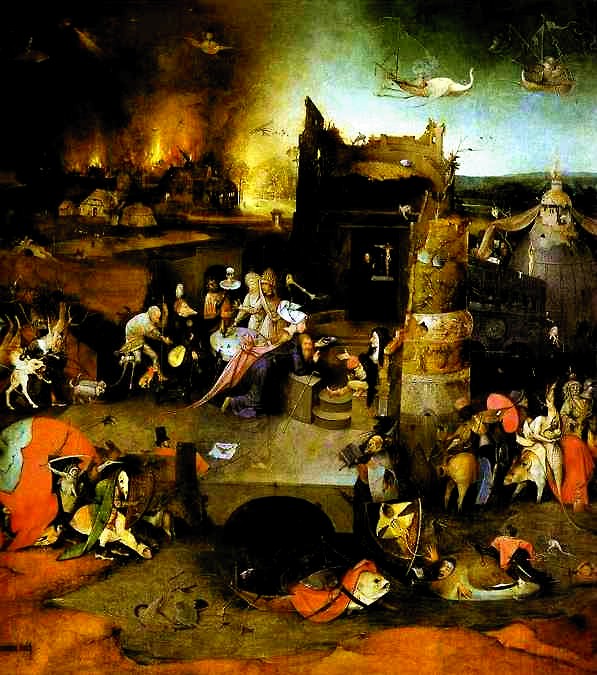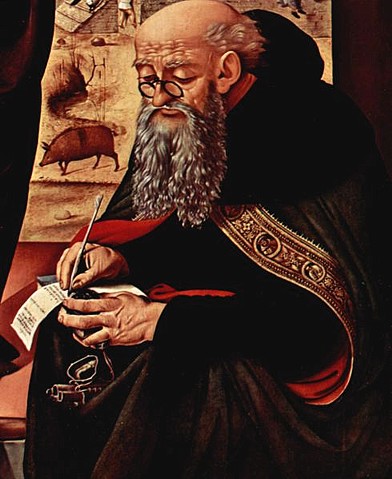Lessico
Sant'Antonio Abate
Santo,
eremita e abate (Coma, Egitto, ca. 250 - 356). Seguendo il consiglio evangelico,
a vent'anni si spogliò dei suoi beni e si diede a vita ascetica,
rinchiudendosi più tardi in un'antica tomba scavata nella montagna. Risalgono
a questo periodo le prime cosiddette Tentazioni di Sant'Antonio![]() , oggetto
di raffigurazioni soprattutto nei secoli XV e XVI.
, oggetto
di raffigurazioni soprattutto nei secoli XV e XVI.
Aveva circa 35 anni quando si rifugiò nel deserto in un castello abbandonato, dove, fattosi murare, rimase per un ventennio senza più uscire, vivendo solo di pane e acqua. Divenuto il luogo meta di visitatori ed estimatori, Antonio organizzò nel 305 il primo nucleo di una comunità di tipo anacoretico.
Successivamente si trasferì verso il Mar Rosso donde la fondazione del famoso monastero copto di Deir-al-Arab. Il santo trascorse il resto della sua lunga vita pregando e combattendo tenacemente l'eresia ariana.
Sant'Atanasio
scrisse su di lui una Vita; l'imperatore Costantino![]() gli si rivolse per lettera. Antonio, che all'età di 90 anni incontrò
l'eremita Paolo di Tebe (morto forse nel 347), morì centenario, raccomandando ai
discepoli di tener segreto il luogo della sepoltura. Festa il 17 gennaio.
gli si rivolse per lettera. Antonio, che all'età di 90 anni incontrò
l'eremita Paolo di Tebe (morto forse nel 347), morì centenario, raccomandando ai
discepoli di tener segreto il luogo della sepoltura. Festa il 17 gennaio.
La
ricorrenza del santo è annunciata in più luoghi, la sera della vigilia, con
l'accensione di falò: manifestazione che si riconnette al potere attribuito
al monaco egiziano di guarire dal fuoco sacro o di Sant'Antonio (herpes
zoster![]() )
e che ha assunto talvolta uno spiccato valore folcloristico (nota la “festa
delle farchie”, fasci di canne portati in processione e poi incendiati a
Fara Filiorum Petri, in Abruzzo, provincia di Chieti). Il giorno della sua festa è celebrato nel
mondo cattolico anche con la benedizione degli animali, soprattutto domestici,
di cui Sant' Antonio è ritenuto protettore.
)
e che ha assunto talvolta uno spiccato valore folcloristico (nota la “festa
delle farchie”, fasci di canne portati in processione e poi incendiati a
Fara Filiorum Petri, in Abruzzo, provincia di Chieti). Il giorno della sua festa è celebrato nel
mondo cattolico anche con la benedizione degli animali, soprattutto domestici,
di cui Sant' Antonio è ritenuto protettore.

Sant'Antonio è considerato il protettore degli animali domestici, tanto da essere solitamente raffigurato con accanto un maiale che reca al collo una campanella. Tradizionalmente il 17 gennaio la Chiesa benedice gli animali e le stalle ponendoli sotto la protezione del Santo. La tradizione deriva dal fatto che l'ordine degli Antoniani (approvato nel 1095 da Papa Urbano II, i quali, con le questue, mantenevano i loro ospedali dove curavano i pellegrini e gli ammalati) aveva ottenuto il permesso di allevare maiali all'interno dei centri abitati, poiché il grasso di questi animali veniva usato per ungere gli ammalati colpiti dal fuoco di Sant'Antonio. I maiali erano nutriti a spese della comunità e circolavano liberamente nel paese con al collo una campanella.
Quindi, tutti gli animali domestici dovrebbero dire grazie al grasso del maiale nonché all'herpes zoster per il fatto di avere Sant'Antonio come protettore, non certo al fatto che Sant'Antonio non mangiò carne di animali per una ventina d'anni. Ma si tratta di un grazie che per i nostri animali domestici non comporta una vita lunga e serena, anzi, l'opposto! Infatti tutti gli animali domestici debbono essere protetti da Sant'Antonio affinché offrano in fretta cibo ottimo ed abbondante, come accadeva con la carne di maiale dopo che l'utilissimo grasso era stato recuperato per fini terapeutici.

Gallo
fischietto pugliese in terracotta![]() – Usanza vuole che ogni 17 gennaio a Rutigliano, in provincia di Bari, in
occasione della festa che preannuncia l’arrivo del carnevale, ovvero in
occasione della festa di Sant'Antonio Abate, protettore degli animali
soprattutto domestici, che cade appunto il 17 gennaio, come pegno d’amore i
ragazzi regalino alle fanciulle amate un cesto di frutta con all’interno un
fischietto a forma di gallo, simbolo di virilità e fertilità.
– Usanza vuole che ogni 17 gennaio a Rutigliano, in provincia di Bari, in
occasione della festa che preannuncia l’arrivo del carnevale, ovvero in
occasione della festa di Sant'Antonio Abate, protettore degli animali
soprattutto domestici, che cade appunto il 17 gennaio, come pegno d’amore i
ragazzi regalino alle fanciulle amate un cesto di frutta con all’interno un
fischietto a forma di gallo, simbolo di virilità e fertilità.

Pannello
centrale delle Tentazioni di Sant'Antonio – 1500
Hieronymus Bosch (ca. 1450-1516)
Museu Nacional de Arte Antiga - Lisbona
Hieronymus
Bosch è lo pseudonimo del pittore fiammingo Hieronymus van Aeken ('s-Hertogenbosch![]() ca. 1450 - 1516). Di famiglia forse oriunda di Aquisgrana, si suppone un suo
tirocinio in Anversa o a Bruxelles, ma mancano notizie biografiche precise ed
è incerta la stessa cronologia delle opere rimaste. Bosch è la personalità
più complessa e singolare della pittura fiamminga. Con sottigliezze da
miniatore e capacità pittorica ricca di sensibilità coloristica, dipinge
quadri gremiti di figure grottesche e allucinanti, spesso mostruose, di uomini
e di animali, nei quali sono rappresentati in modo simbolico antichi proverbi,
episodi biblici o evangelici, testi mistici medievali, credenze astrologiche o
alchimistiche, non sempre per noi di facile comprensione. Una tematica
comunque che non può certo essere interpretata in chiave di pura fantasia o
di puro divertimento, ma che ha forse la sua radice nell'aspirazione
dell'artista a contribuire al rinnovamento dei costumi religiosi e a
combattere la corruzione.
ca. 1450 - 1516). Di famiglia forse oriunda di Aquisgrana, si suppone un suo
tirocinio in Anversa o a Bruxelles, ma mancano notizie biografiche precise ed
è incerta la stessa cronologia delle opere rimaste. Bosch è la personalità
più complessa e singolare della pittura fiamminga. Con sottigliezze da
miniatore e capacità pittorica ricca di sensibilità coloristica, dipinge
quadri gremiti di figure grottesche e allucinanti, spesso mostruose, di uomini
e di animali, nei quali sono rappresentati in modo simbolico antichi proverbi,
episodi biblici o evangelici, testi mistici medievali, credenze astrologiche o
alchimistiche, non sempre per noi di facile comprensione. Una tematica
comunque che non può certo essere interpretata in chiave di pura fantasia o
di puro divertimento, ma che ha forse la sua radice nell'aspirazione
dell'artista a contribuire al rinnovamento dei costumi religiosi e a
combattere la corruzione.

Painting
of Saint Anthony ca. 1480
by Piero di Cosimo (Firenze 1461/62-1521)
Saint
Anthony the Great (ca.251 - 356), also known as Saint Anthony Abbot, Saint
Anthony of Egypt, Saint Anthony of the Desert, Saint Anthony the Anchorite,
and The Father of All Monks, was an Egyptian Christian saint and the
outstanding leader among the Desert Fathers, who were Christian monks in the
Egyptian desert in the 3rd and 4th centuries. He was located in Alexandria,
Egypt for some of his life. His feast day is celebrated on January 17th in
some churches, but celebrated on Tobi 22 (January 30) in the Coptic Orthodox
Church and the Coptic Catholic Church, which have the closest cultural and
geographical ties to him. Saint Anthony is appealed to against infectious
diseases, in particular herpes zoster![]() , hence
shingles are known as Saint Anthony's fire in Italy and Malta.
, hence
shingles are known as Saint Anthony's fire in Italy and Malta.
Life of St. Anthony
Most of what we know about the life of St Anthony is in the Greek vita (Life of Antony) by Athanasius, circulated in Latin. Several surviving homilies and epistles of varying authenticity provide scant autobiographical detail.
Anthony was born near Herakleopolis Magna in Upper Egypt in 251 to wealthy parents. When he was eighteen years old, his parents died and left him with the care of his unmarried sister. In 285, he decided to follow the words of Jesus who had said: "If you want to be perfect, go, sell what you have and give to the poor, and you will have treasures in heaven; and come, follow Me." (Matthew 19:21). Anthony gave his wealth to the poor and needy, and placed his sister with a group of Christian virgins, a sort of proto-nunnery at the time.
The moniker "Father of Monasticism" is misleading, as Christian monasticism was already being practiced in the deserts of Egypt. Ascetics commonly retired to isolated locations on the outskirts of cities. Anthony is notable for being one of the first ascetics to attempt living in the desert proper, completely cut off from civilization. His anchoritic (isolated) lifestyle was remarkably harsher than his predecessors. By the 2nd century there were also famous Christian ascetics, such as Saint Thecla. Saint Anthony decided to follow this tradition and headed out into the alkaline desert region called the Nitra in Latin (Wadi El Natrun today), about 95 km west of Alexandria, some of the most rugged terrain of the Western Desert.
Also note that pagan ascetic hermits and loosely organized coenobitic communities that the Hellenized Jewish philosopher Philo of Alexandria described as the Therapeutae in the first century, were long established in the harsh environments by the Lake Mareotis close to Alexandria, and in other less-accessible regions. Philo understood: for "this class of persons may be met with in many places, for both Greece and barbarian countries want to enjoy whatever is perfectly good." (Philo, De vita contemplativa written c. 10)
According to Athanasius, the devil fought St Anthony by afflicting him with boredom, laziness, and the phantoms of women, which he overcame by the power of prayer, providing a theme for Christian art. After that, he moved to a tomb, where he resided and closed the door on himself, depending on some local villagers who brought him food. When the devil perceived his ascetic life and his intense worship, he was envious and beat him mercilessly, leaving him unconscious. When his friends from the local village came to visit him and found him in this condition, they carried him to a church.
After he recovered, he made a second effort and went back to the desert, further out, to a mountain by the Nile, called Pispir, now Der el Memun, opposite Arsinoë in the Fayyum. There he lived strictly enclosed in an old abandoned Roman fort for some twenty years. According to Athanasius, the devil again resumed his war against Saint Anthony, only this time the phantoms were in the form of wild beasts, wolves, lions, snakes and scorpions. They appeared as if they were about to attack him or cut him into pieces. But the Saint would laugh at them scornfully and say, "If any of you have any authority over me, only one would have been sufficient to fight me." At his saying this, they disappeared as though in smoke, and God gave him the victory over the devil. While in the fort he only communicated with the outside world by a crevice through which food would be passed and he would say a few words. Saint Anthony would prepare a quantity of bread that would sustain him for six months. He did not allow anyone to enter his cell: whoever came to him, stood outside and listened to his advice.
Then one day he emerged from the fort with the help of villagers to break down the door. By this time most had expected him to have wasted away, or gone insane in his solitary confinement, but he emerged healthy, serene, and enlightened. Everyone was amazed that he had been through these trials and emerged spiritually rejuvenated. He was hailed as a hero and from this time forth the legend of Anthony began to spread and grow.
Then he went to the Fayyum and confirmed the brethren there in the Christian faith, then returned to his old Roman fort. Anthony wished to become a martyr and went to Alexandria. He visited those who were imprisoned for the sake of Christ and comforted them. When the Governor saw that he was confessing his Christianity publicly, not caring what might happen to him, he ordered him not to show up in the city. However, the Saint did not heed his threats. He faced him and argued with him in order that he might arouse his anger so that he might be tortured and martyred, but it did not happen.
When he went back to the old Roman fort, many came to visit him and to hear his teachings. He saw that these visits kept him away from his worship. As a result, he went further into the Eastern Desert of Egypt. He traveled to the inner wilderness for three days, until he found a spring of water and some palm trees, and then he chose to settle there. On this spot now stands the monastery of Saint Anthony the Great. On occasions, he would go to the monastery on the outskirts of the desert by the Nile to visit the brethren, then return to his inner monastery.
The
backstory of one of the surviving epistles, directed to Constantine I![]() recounts how the fame of Saint Anthony spread abroad and reached Emperor
Constantine. The Emperor wrote to him, offering him praise and asked him to
pray for him. The brethren were pleased with the Emperor's letter, but Anthony
did not pay any attention to it, and he said to them, "The books of God,
the King of Kings and the Lord of Lords, commands us everyday, but we do not
heed what they tell us, and we turn our backs on them." Under the
persistence of the brethren who told him, "Emperor Constantine loves the
church," he accepted to write him a letter blessing him, and praying for
the peace and safety of the empire and the church.
recounts how the fame of Saint Anthony spread abroad and reached Emperor
Constantine. The Emperor wrote to him, offering him praise and asked him to
pray for him. The brethren were pleased with the Emperor's letter, but Anthony
did not pay any attention to it, and he said to them, "The books of God,
the King of Kings and the Lord of Lords, commands us everyday, but we do not
heed what they tell us, and we turn our backs on them." Under the
persistence of the brethren who told him, "Emperor Constantine loves the
church," he accepted to write him a letter blessing him, and praying for
the peace and safety of the empire and the church.
According to Athanasius, Saint Anthony heard a voice telling him, "Go out and see." He went out and saw an angel who wore a girdle with a cross, one resembling the holy Eskiem (Tonsure or Schema), and on his head was a head cover (Kolansowa). He was sitting while braiding palm leaves, then he stood up to pray, and again he sat to weave. A voice came to him saying, "Anthony, do this and you will rest." Henceforth, he started to wear this tunic that he saw, and began to weave palm leaves, and never got bored again. Saint Anthony prophesied about the persecution that was about to happen to the church and the control of the heretics over it, the church victory and its return to its formal glory, and the end of the age. When Saint Macarius visited Saint Anthony, Saint Anthony clothed him with the monk's garb, and foretold him what would be of him. When the day drew near of the departure of Saint Paul the First Hermit in the desert, Saint Anthony went to him and buried him, after clothing him in a tunic which was a present from St Athanasius the Apostolic, the 20th Patriarch of Alexandria.
When Saint Anthony felt that the day of his departure had approached, he commanded his disciples to give his staff to Saint Macarius, and to give one sheepskin cloak to Saint Athanasius and the other sheepskin cloak to Saint Serapion, his disciple. He further instructed his disciples to bury his body in an unmarked, secret grave, lest his body become an object of veneration. He stretched himself on the ground and gave up his spirit. Saint Anthony the Great lived for 105 years and departed on the year 356. He probably spoke only his native language, Coptic, but his sayings were spread in a Greek translation. He himself left no writings. His biography was written by Saint Athanasius and titled Life of Saint Anthony the Great. Many stories are also told about him in various collections of sayings of the Desert Fathers.
Some of the stories included in Saint Anthony's biography are perpetuated now mostly in paintings, where they give an opportunity for artists to depict their more lurid or bizarre fantasies. Many pictorial artists, from Hieronymus Bosch to Salvador Dalí, have depicted these incidents from the life of Anthony; in prose, the tale was retold and embellished by Gustave Flaubert.
Founder of monasticism
Saint Anthony and Saint Paul the Hermit are seen as the founders of Christian monasticism. Saint Paul the Hermit is lauded by Saint Anthony as the first hermit. The monastery of Saint Paul the Hermit exists to this day in Egypt. Saint Cax himself provided the example that others would follow (see Saint Pachomius). Anthony himself did not organize or create a monastery, but a community grew up around him based on his example of living an ascetic and isolated life. Those who wished to follow him needed the company of others to survive the harsh conditions.